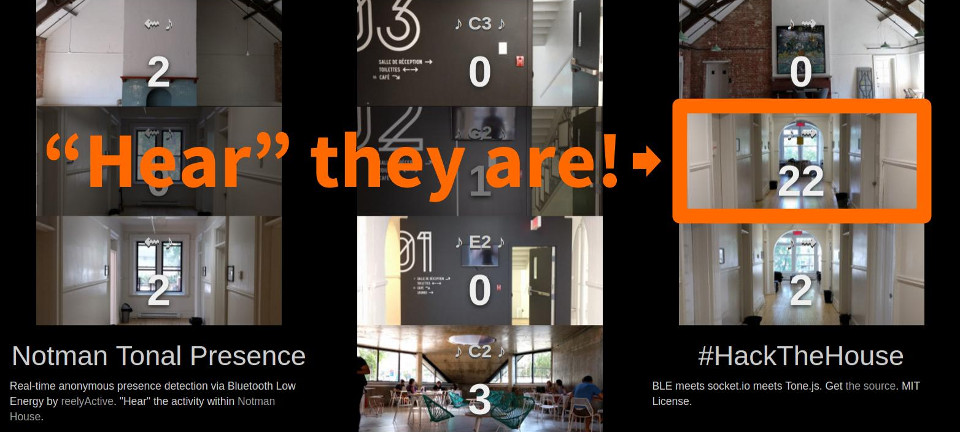Imagine you could “hear” Bluetooth devices moving through a building. In anticipation of last weekend’s #HackTheHouse hackathon for smart buildings, hosted at Notman House where we’ve had our technology deployed since 2012, we created the Notman Tonal Presence web application to do just that.
On each of Notman’s three floors, there are three of our Bluetooth Low Energy (BLE) sensors (which we call reelceivers), plus an addition sensor in the adjacent OSMO Cafe.
Think of each floor as a musical note in a scale (C – E – G – C), and each wing of that floor as a pan in stereo (Left – Centre – Right).
When BLE devices “appear” and “disappear” they produce a note which encodes the location by the tonality and pan. Same thing when BLE devices “displace” from one zone to another, only these use a ping-pong delay rather than a pan.
For the hackathon, we ordered three packs of Estimote Nearables which are BLE devices that periodically transmit their temperature and 3-axis acceleration. Unfortunately, these were held up in customs and didn’t make it in time. But the web app essentially turns these into “hearable nearables” and, as you’ll pick out in the video, we could tell not only when they had arrived, but also where in the house they were:
Yes, they’re on the second floor east (right) wing. Why so noisy? As we discussed in our ObservaBLE Etiquette blog post, the Estimote Nearables cycle their identifier with every transmission. To an observer, that would be interpreted as a new device “appearing” each time. Hence plenty of appearance and disappearance notes in the web application.

To reinforce this point, have a look at the Google Analytics (GA) timeline for Notman House. Our platform pushes all the events from the house to GA (see our Google Analytics for the Physical World blog post), where each is interpreted as a session based on its identifier. The Nearables’ aggressive identifier-cycling results significantly biases the number of sessions, and hence we can tell from the edge of the high plateau when they arrived: shortly after 16h on November 15th.
We created the Notman Tonal Presence application as an example of calm technology for smart buildings. The ambient sounds allow the listener to subconsciously register foot traffic within the building while leaving their attention free for other tasks. Even the casual listener would have been gently alerted to the arrival of the Nearables, which is precisely the objective of calm technology. And, now, duly alerted, we can direct our attention towards filtering out the Nearables from GA so that their incessant identifier-cycling doesn’t saturate the session counts!
